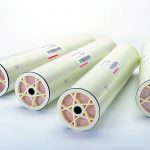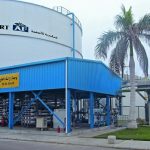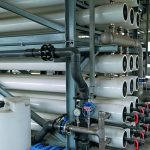AlexFert is a large fertiliser company located in Alexandria, Egypt. The company was interested in reducing the cost of its high purity water treatment operations by using a reverse osmosis (RO) membrane process as a desalination step to reduce the ionic burden on its ion exchange system. Lanxess and its engineering partner, AL-Emain Engineering Co. of Mansoura (Egypt), designed and supplied a high performance RO system to meet the client’s objectives.
When planning the water treatment system for Alexandria Fertilisers Co. (AlexFert), Egypt’s leading fertiliser producer, Lanxess chose Lewaplus – the reverse osmosis (RO) and ion exchange system design software. This software offers a way to project the performance of Lewabrane RO membranes under the expected conditions of service. With only a few inputs (permeate quantity, feed water and source, temperature and pretreatment steps), Lewaplus automatically dimensions a default RO system design that meets the customer’s stated targets. The software calculates a system array, feed pressures for pump sizing and permeate quality. The projected permeate quality can be used to assess the reduction in ionic burden on a downstream ion exchange system. The software also provides warnings if design guidelines for critical system parameters are not within limits.
Another aspect of the Lewaplus design software was important for this particular project. A client often needs to know how the performance of the RO plant will change over time. It is quite common for the equipment supplier to project the performance (feed pressures and permeate quality) on a 3-year basis (that is, how the RO system will perform after 3 years in service). This also serves as the basis for guarantees in capital projects. Lewaplus design software allows the user to enter unique, or use default, values for the flux decline ratio (water permeability of the membrane) and salt passage increase over a period of up to seven years. For this project, the user was supplied with performance projections for 0, 1, 3, and 5 years.
Membrane element selection
The RO membrane element is generally selected as a function of the water source and the pretreatment steps. The AlexFert water treatment plant uses canal water as the source (originally from the River Nile) with a seasonally variable TDS of 300 to 550 mg/l. The water composition used for the design basis was measured and found to contain 3 ppm TOC, 0.3 NTU units, an SDI of 4 and a total iron content of 0.2 ppm. These levels are generally attributed to waters prone to organic fouling.
The feed water to the RO system is pretreated by coagulation, cold lime softening and cartridge filtration. Lanxess recommended that the RO system should be based on Lewabrane B400 FR membrane elements. These are workhorse elements for industrial applications. They are standard pressure elements characterised by high flow productivity and excellent salt rejection. One aspect of special importance is that Lewabrane B400 FR elements ship with a 34 mil (0.86 mm) feed spacer which is recommended for potentially fouling waters, such as slow moving canal water. Feed spacers with a height of 34 mil are considered to be the industry standard in situations liable to membrane fouling.
Another key reason for recommending the Lewabrane B400 FR relates to silica rejection. The polyamide layer of the elements is prepared with a higher level of cross linkage in the barrier layer. The separation mechanism is thus more dominated by solution diffusion effects than by anionic repulsion from a carboxylic charge on the membrane surface. This denser PA layer results in higher rejection of bulky anions in solution, such as silicate, borate or arsenate. The improved silica rejection performance is especially significant in applications with high pressure boilers of the kind typically encountered in the fertiliser industry.
A glance at the design software projection confirms the superior silica rejection performance. The design feed water analysis shows the salt rejection calculated as 98.6 % system rejection (938 ppm feed; 12.8 ppm TDS in permeate). A similar calculation can be carried out for silica in permeate. This results in 99.35 % system rejection for silica (8 ppm feed; 52 ppb silica in permeate).
Current water treatment system
The new reverse osmosis system was delivered by AL-Emain Engineering in 2015. The RO units were placed into an existing water treatment plant upstream of ion-exchange full demineralisation trains (SAC – WBA/SBA – MB, each vessel installed with Lewatit resins). Cartridge filtration was added upstream of the RO pumps to protect the RO system. The RO plant consists of two trains, each with a 120 m3/h feed stream and operating at 74 % recovery. A single train is composed of two stages in a 13:6 array with six elements per vessel.
Since being put into operation, the Lewabrane elements have demonstrated excellent salt rejection of up to 99.76 % (at 20 °C). This rejection leads to permeate conductivity in the order of 3 to 5 µS/cm, which significantly reduces the ionic load on the resins at the demineralisation unit. The regeneration cycle times of the demineralisation trains have been approximately quadrupled (depending on the season and with scope for a further increase). The customer’s consumption of regeneration chemicals for the ion exchange resin trains has accordingly been reduced by about 60 %.
Excellent performance
The Lewabrane B400 FR shows excellent performance with problematic Nile surface water. The measured rejections exceed expectations. The combination of Lewabrane B400 FR membranes and Lewatit Monoplus resins for demineralisation met the client’s specification of 0.08 µS/cm and 2 ppb SiO2 final demineralised water conductivity. The RO plant additionally enabled a reduction in regeneration chemical consumption for the downstream ion exchange resins, and less operator intervention is needed because regeneration takes place less often.
www.cpp-net.com search: cpp0217lanxess
Dr. Jens Lipnizki
Head of Technical Marketing Membrane, Business Unit Liquid Purification Technologies
Lanxess
Alan Sharpe
Consultant to Lanxess
Designed for demanding applications

Facts & Figures
The Lewabrane RO family consists of spiral-wound, thin-film composite membrane elements designed specifically for water treatment applications. The RO membrane chemistry and element construction provide optimised, low-cost operation for downstream unit applications like separate-bed or mixed-bed ion exchange units.
Lewabrane RO B400 FR elements ensure more turbulence in the feed water spacer in combination with the highly cross linked, low surface charge Lewabrane membrane. These reverse osmosis elements are recommended for brackish and low-salinity feed waters that are more prone to biological and organic fouling tendencies.
Share:








